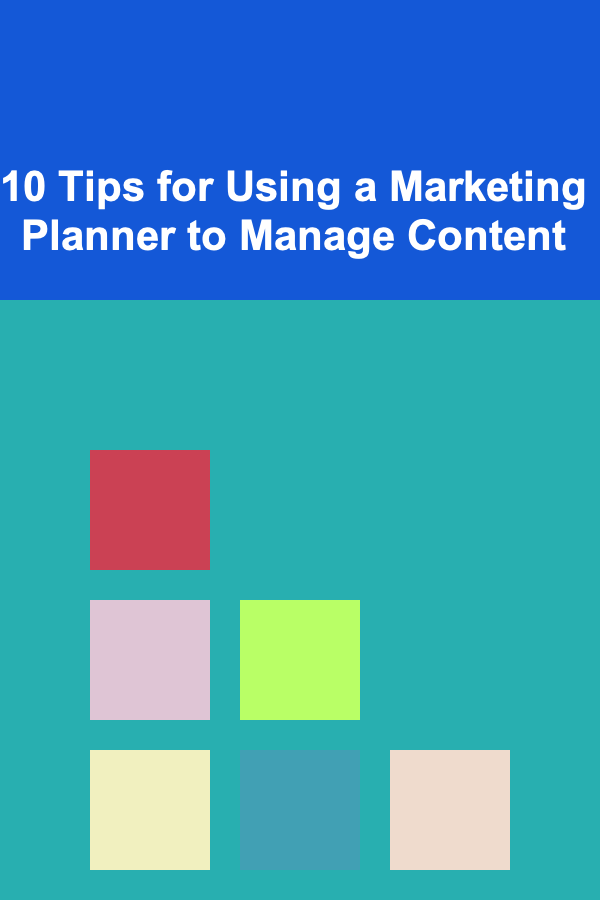
10 Tips for Using a Marketing Planner to Manage Content
ebook include PDF & Audio bundle (Micro Guide)
$12.99$5.99
Limited Time Offer! Order within the next:

A marketing planner is an essential tool for managing and organizing content creation, distribution, and performance tracking. In the fast-paced world of digital marketing, having a strategic approach to content management ensures that campaigns remain on track, deadlines are met, and objectives are achieved. Whether you're managing a small business or overseeing a large-scale marketing campaign, using a marketing planner effectively can make a significant difference.
This guide provides ten actionable tips for utilizing a marketing planner to its fullest potential. These tips will help streamline your content process, improve collaboration, and ultimately enhance the overall effectiveness of your marketing efforts.
Define Clear Objectives and KPIs
The first step in using a marketing planner effectively is to set clear, measurable objectives. Without defined goals, it's easy to get lost in the daily tasks of content creation and forget about the bigger picture. Your marketing planner should be used to track the progress of your goals and keep your team aligned.
Setting Objectives:
- SMART Goals: Use the SMART framework to set specific, measurable, achievable, relevant, and time-bound goals. For instance, increasing website traffic by 20% in the next quarter or growing social media engagement by 15% within a month.
- KPIs (Key Performance Indicators): Establish KPIs to measure success. These could include metrics like lead generation, social media interactions, conversion rates, or email click-through rates.
A marketing planner should be updated regularly to monitor progress toward these goals, allowing you to adjust strategies as needed.
Create a Content Calendar
One of the most powerful features of a marketing planner is its ability to map out content in advance. A content calendar ensures that you plan and organize your posts, blogs, emails, and other marketing materials ahead of time. This approach helps eliminate last-minute scrambling and ensures that content is consistent and aligned with your overall marketing strategy.
Tips for Creating a Content Calendar:
- Frequency: Decide how often you want to post content on each platform. This could vary depending on the platform (e.g., daily posts on social media, weekly blog posts).
- Themes and Topics: Identify key themes and topics for each month or week, ensuring that the content is relevant to your target audience. This can also help you stay organized and ensure that content aligns with your broader marketing goals.
- Important Dates: Mark holidays, product launches, and industry events in your calendar. These dates can serve as opportunities for time-sensitive content.
Using a content calendar allows you to visualize your content distribution, manage deadlines, and avoid content gaps.
Collaborate Effectively
In many marketing teams, collaboration is crucial for creating high-quality content. A marketing planner can act as a central hub for communication and collaboration, allowing team members to share updates, track progress, and provide feedback.
Ways to Collaborate Using a Marketing Planner:
- Assign Tasks: Use your planner to assign specific tasks to team members. This ensures accountability and keeps everyone aligned on their responsibilities.
- Track Progress: Regularly update the status of tasks in your planner. This could include "not started," "in progress," or "completed" to ensure that everyone knows where things stand.
- Share Feedback: A marketing planner allows you to leave comments or notes for team members, making it easier to share feedback and make adjustments before content is finalized.
Effective collaboration will help streamline the content creation process and prevent bottlenecks.
Plan for Different Content Types and Platforms
Not all content is created equal, and not all platforms are the same. Different types of content may be more suitable for different platforms. For instance, blog posts are great for providing in-depth content, while short videos or infographics work well on social media. A marketing planner allows you to plan content for various types and platforms, ensuring that you maximize your content's reach and impact.
Tips for Planning Content Across Platforms:
- Repurpose Content: Repurposing content is an efficient way to maximize your output. For example, a long-form blog post can be broken into smaller social media posts or turned into a video.
- Tailor Content to Each Platform: Customize your messaging, visuals, and tone for each platform. What works on Instagram might not resonate on LinkedIn or Twitter, so make sure the content aligns with the audience on each platform.
- Diversify Content Types: Include a mix of content types in your planner, such as blog posts, videos, infographics, podcasts, and email newsletters. This keeps your content fresh and engaging.
A marketing planner allows you to ensure that content is distributed appropriately across platforms and maintains consistency in messaging.
Prioritize Content Based on Audience Needs
Understanding your audience is key to creating relevant and engaging content. A marketing planner can be a great tool for ensuring that your content is aligned with the needs and interests of your target audience. Prioritize content based on what your audience is searching for, asking about, or engaging with.
Ways to Prioritize Audience-Centered Content:
- Research Trends: Use tools like Google Trends, BuzzSumo, or social media listening tools to discover popular topics within your industry. This will help you tailor your content to what your audience cares about.
- Engage with Your Audience: Regularly monitor comments, feedback, and social media interactions to gauge what topics or issues are most important to your audience. This can inform your content strategy.
- Content Formats Based on Preferences: If your audience prefers short-form videos, prioritize creating those types of content. If they engage more with blog posts or case studies, focus your energy on producing that type of content.
Aligning your content with your audience's needs increases engagement and improves the performance of your marketing efforts.
Schedule Regular Content Reviews
Regular reviews are essential for staying on track with your content plan. A marketing planner allows you to schedule content review meetings, during which you can analyze the performance of past content and make adjustments for future campaigns.
How to Schedule Content Reviews:
- Monthly Review: Set a recurring meeting at the end of each month to review the performance of the content published that month. Use analytics tools to measure metrics like traffic, engagement, and conversions.
- Adjust Strategies: Based on your review, make necessary adjustments to your content plan. If certain types of content are performing better than others, focus more on those moving forward.
- Incorporate Team Feedback: Use the review process to gather input from team members and stakeholders. Their insights can help shape future content strategies.
Regular content reviews will ensure that your marketing efforts stay aligned with your goals and that you continue to improve over time.
Track Content Performance with Analytics
A marketing planner should be integrated with analytics tools to help track the performance of your content. Analytics provide valuable insights into how well your content is resonating with your audience and whether you are meeting your objectives.
Key Metrics to Track:
- Traffic: Monitor the number of visitors coming to your website or landing pages from your content.
- Engagement: Track likes, comments, shares, and other forms of social media interaction to gauge how well your audience is engaging with your content.
- Conversion Rates: Measure how well your content is driving conversions, whether that's making a sale, generating a lead, or prompting another desired action.
By tracking content performance, you can refine your content strategy, ensuring that you invest in what works and improve what doesn't.
Integrate SEO Strategy into Content Planning
Search engine optimization (SEO) is a critical part of any content marketing strategy. Integrating SEO into your marketing planner will ensure that your content is optimized for search engines, improving its visibility and ranking.
SEO Tips for Content Planning:
- Keyword Research: Use tools like Google Keyword Planner or SEMrush to research keywords that are relevant to your content. Incorporate these keywords naturally into your content to improve its search ranking.
- Optimize On-Page SEO: Include SEO best practices like using header tags, meta descriptions, alt text for images, and internal linking to boost your content's SEO performance.
- Content-Length and Structure: Aim for content that is comprehensive but easy to read. Long-form content often performs better in search engine results, but it must be well-structured and easy to navigate.
Incorporating SEO into your content planning ensures that your content is not only relevant and engaging but also discoverable by your target audience.
Stay Flexible and Adapt to Changes
The marketing landscape is constantly evolving. A strategy that works today might not be as effective tomorrow. A marketing planner allows you to stay flexible and adapt to changes in trends, algorithms, or audience preferences.
How to Stay Flexible:
- Monitor Industry Changes: Keep an eye on changes in your industry or digital marketing landscape. Adjust your content strategy to stay ahead of trends.
- Respond to Feedback: Be open to feedback from your audience and stakeholders. If something isn't working, be willing to pivot and try a different approach.
- Test New Ideas: Don't be afraid to experiment with new content formats, platforms, or approaches. Your marketing planner can help you track the results of these experiments and adjust accordingly.
Staying flexible and adaptable ensures that your marketing strategy remains relevant and effective in a rapidly changing environment.
Automate Where Possible
Marketing planners often have features that allow for automation, which can save time and improve efficiency. Automating parts of the content creation and distribution process can help you focus on strategy and creativity, while still ensuring that your content is being delivered consistently.
Areas to Automate:
- Social Media Posting: Use tools like Hootsuite or Buffer to schedule and automate social media posts based on your content calendar.
- Email Marketing: Set up automated email campaigns that are triggered by certain actions, like signing up for a newsletter or completing a purchase.
- Content Curation: Use content curation tools to automatically find and share relevant content with your audience, saving you time on manual content discovery.
Automation helps reduce manual tasks and ensures that content is consistently delivered without the need for constant oversight.
Conclusion
A marketing planner is an invaluable tool for managing content, tracking performance, and staying organized in the fast-paced world of digital marketing. By following these ten tips, you can effectively use your marketing planner to optimize your content strategy, streamline your processes, and achieve your business goals. Whether you are a small business owner or part of a large marketing team, the right planning tools will ensure that your content efforts are impactful and well-executed.
Reading More From Our Other Websites
- [Scrapbooking Tip 101] The Mindful Benefits of Scrapbooking: Stress Relief for Grown-Ups
- [Mindful Eating Tip 101] Best Mindful Eating for Parents: Raising Healthy Eating Habits in Your Family
- [Home Renovating 101] How to Incorporate Bold Design Trends into Your Renovation
- [Home Rental Property 101] How to Choose Between Short-Term and Long-Term Rental Agreements
- [Home Storage Solution 101] How to Set Up a Storage System for Your Digital Devices and Cables
- [Organization Tip 101] How to Plan for Photography and Videography Needs
- [Organization Tip 101] How to Use Time-Tracking Apps for Better Productivity
- [Home Security 101] How to Integrate Smoke and Fire Alarms into Your Home Security System
- [Personal Care Tips 101] How to Choose the Right Mascara Brush for Your Lashes
- [Organization Tip 101] How to Use Clear Bins for Attic Organization

Developing and Selling Deep Learning Models for Profit
Read More
How to Evaluate Investment Opportunities in Cryptocurrencies
Read More
How to Make Your Own Natural Cleaning Products at Home
Read More
How to Sell Digital Products Successfully for Students: An Actionable Guide
Read More
How to Plan for Pet Care in Your Estate
Read More
How to Develop a Horse Deworming Schedule Checklist
Read MoreOther Products

Developing and Selling Deep Learning Models for Profit
Read More
How to Evaluate Investment Opportunities in Cryptocurrencies
Read More
How to Make Your Own Natural Cleaning Products at Home
Read More
How to Sell Digital Products Successfully for Students: An Actionable Guide
Read More
How to Plan for Pet Care in Your Estate
Read More